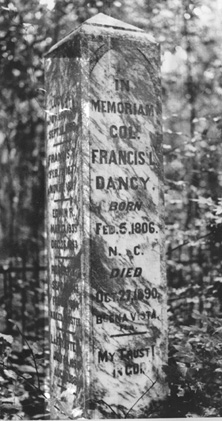
Col. Francis L. Dancy (1806-1890)
Inducted 2013
Highlights
Col. Dancy was perhaps the most significant figure in Florida’s early citrus industry. In addition to be a widely succcesful citrus grower, Dancy was also a soldier, civil engineer, mayor of St. Augustine, Florida State Representative, state engineer and geologist. Educated fellow growers on more effective growing methods and contributed to the industry the “Dancy Tangerine.” Soon became widely popular after he distributed cuttings to fellow growers in 1872.
- Seminole War
- St. Augustine
- Florida State House of Representatives
- Buena Vista
- Dancy Tangerines
Bio
Soldier, engineer, civil servant, and planter—Francis Dancy was perhaps the most significant figure in Florida’s early citrus industry. An Engineer trained at the U. S. Military Academy, Dancy graduated in 1826 and immediately entered artillery school at Ft. Monroe, Virginia. When the Seminole War erupted in 1835, Dancy, already in Florida, became Quartermaster of the Florida forces. After resigning his commission in 1836, Dancy was hired as a civil engineer, working on projects like the St. Augustine sea wall. Such accomplishments led to his election as mayor of St Augustine. In 1841, Col. Dancy was elected to the Florida State House of Representatives. Soon after, in 1844, he moved to an expanse of land on the St. John’s River, where he built Buena Vista, his plantation where he developed many varieties of citrus. Even as his plantation prospered, Dancy served as Florida’s State Engineer and Geologist.
According to historian David S. Shields, Dancy “epitomized the omni-competent public man and planter experimentalist.” Even after freezes decimated citrus in East Florida in the 1830s, Dancy incentivized planters to plant oranges rather than sugar, arguing that citrus could be more profitable in the future. Dancy also discovered that cutting citrus trees back to stumps would strengthen the root system, thus making the tree more resistant to freezes.
In 1842, when the scale insect invaded, Dancy advocated for the diversification of groves with Lemons, which were resistant to the scale. He also realized that budded, rather than seedling trees, were more resistant to the scale. Due to the price of lemons being comparable to that of oranges, many groves stayed financially sound during the scale crisis. Perhaps Dancy’s greatest contribution to the citrus industry was the “Dancy Tangerine.” Dancy’s breed was notable for its easy to peel skin, moderate number of seeds, and sweet flavor. In 1872, Dancy distributed cuttings to his fellow growers and the Dancy Tangerine quickly gained notoriety. Along with his contribution to the citrus industry, Dancy continually experimented with other fruits such as apples and guavas.
Dancy remained active in agriculture as a scientist and a planter until his death in 1890. Dancy, a pioneer for Florida citrus, was one of the most influential figures in the industry and is remembered today by many in the agricultural community.
